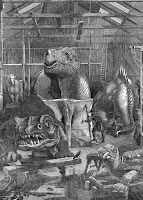Cryptozoology:
A Curates Egg of Impossible Taxidermy
by
Heather Tweed
 |
| The Tasmanian Wolf was actually a carnivorous marsupial |
The strange solitary creature
paces its cage, back and forth. Forever looped in haunting melancholy. It is a
strange made-up sort of animal, part dog, part striped marsupial, with an odd
thick, static, kangaroo tail that it can never wag. The Thylacine was declared
extinct in the1980's. The last lonely survivor lived in Hobart zoo and died in 1936.
The animal was once real, but seeing the oddly
proportioned hybrid in its taxidermied form, preserved for ever in a glass case
can be an oddly jarring sight. It looks cobbled together. Does its three
dimensional form, the texture and the pattern of its pelt have more of a
visceral reality than a photograph, a film, or does the static sculpture
distance us? We need to be reminded that this once living creature moved,
hunted, scavenged, thrived in Tasmania.
 |
| The Dodo at Bristol Museum Heather Tweed 2017 |
More familiar in popular culture is the Dodo,
immortalised in Alice In Wonderland. Again a real beast that can be seen
in models that we believe to be a true likeness. But we are mistaken. Only
parts of this committee designed bird exist and descriptions are scant, a few
sketches from the 17th century exist. We are asked to believe in this creature
although it no longer roams the earth and we are sculpting a best
guess at what it looked like. Our familiarity with its oft printed image also
means that we are perhaps not as astounded as we might once have been.
Sceptical 18th century scientists at first
refused to believe that the platypus was a real beast, searching for stitches
on a specimen.
In the late 19th century an explorer and
illustrator returned to his family home from an long expedition. Exhausted and
penniless he needed distraction. A bon viveur and consummate entertainer,
reputedly enlivening many a dinner party by crawling on all fours and biting
his guests legs, he was bored, fed up. In line with the fashions of the day he
decided to alleviate his ennui by learning the art of taxidermy. The result was
a collection of extaordinary, intricately crafted animals, a kitten with angel
wings, a yeti and a curious bat-duck hybrid with bird wings, webbed feet and
fangs. The creatures look plausible but Professor Copperthwaite their creator
is a fiction.
A sub genre of this form of cryptozoology exists
in the form of sometimes whimsical, sometimes moralising, sometimes conceptual
tableau in which real animals are anthropomorphised, costumed, placed out of
context. Polly Morgan produces sometimes breathtakingly beautiful artwork,
preserving and modelling the animals herself then placing them in incongruous
yet poignant juxtapositions, a fox curled luxuriously in a hunters top hat, a
tiny bird severed in mid flight by a pane of glass.
Arch shock tactic taxidermy-artist Damien Hirst
famously bid an unsuccessful million pounds, to keep the work of Walter Potter
together. One example, immovable and preserved as long as the mothballs last,
is the charmingly frightful cat orchestra.
Charles Avery has taken the art form to its
logical conclusion and populated his illustrated stories with life-size three
dimensional imagined creatures.
 |
| Depiction of the Fiji Mermaid |
There are of course hoaxes, The Fiji Mermaid, a
quite convincing 1842 merging of shriveled monkey and fish tail. Aimed at
deliberate deception to entice more visitors to P.T Barnums extraodinary shows.
Standing before the convincing taxidermied form
of a Satyr, a unicorn, a winged dragon, would some of us not desire believe that
these creatures once existed?
Only dinosaur bones and illustrations stretching back
to ancient China once informed the Victorian public of the true nature of these
terrible monsters. Picnicking beneath the snaking neck of a brontosaurus in the
Crystal Palace exhibition of 1850 perhaps the families sitting on neat tartan
rugs, tucking into their lunch wondered if these beasts could ever have really
roamed the earth?
 |
| Crystal Palace dinosaurs in the artists studio |
 |
| Thylacine at National Museum of Scotland. Heather Tweed 2016 |
Charles Avery nationalgalleries.org/whatson/exhibitions/the-islanders-an-introduction/highlights-6048


No comments:
Post a Comment